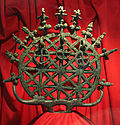A crannog (/ˈkrænəɡ/; Irish: crannóg [ˈkɾˠan̪ˠoːɡ]; Scottish Gaelic: crannag [ˈkʰɾan̪ˠak]) is typically a partially or entirely artificial island, usually...
28 KB (3,076 words) - 23:01, 5 November 2024
307°N 6.297°W / 54.307; -6.297 Loughbrickland Crannóg is a Bronze Age human-made island known as a crannóg, four miles (6.5 km) south west of Banbridge...
2 KB (133 words) - 23:00, 6 July 2024
The Breachacha crannog is a crannog located near Loch Breachacha, on the Inner Hebridean island of Coll. The crannog is recognised in the United Kingdom...
4 KB (428 words) - 13:43, 29 January 2024
Kenmore, Perth and Kinross (redirect from Scottish Crannog Centre)
redeveloped into a number of tourist attractions. The Scottish Crannog Centre (formerly the Crannog Reconstruction Project) is an open-air museum on the south...
11 KB (905 words) - 18:56, 7 November 2024
Loch Tay (section Scottish Crannog Centre)
– AD 30 Milton Morenish Crannog 810 – 390 BC Eilean Breaban Crannog AD 420–640 & 600–400 BC (two occupations) Tombreck Crannog 170BC–AD180 As well as round...
12 KB (1,251 words) - 01:44, 22 October 2024
the Copts of Egypt. Gaelic kings and aristocrats occupied ringforts or crannógs. Church reforms during the 12th century via the Cistercians stimulated...
223 KB (19,826 words) - 07:15, 10 November 2024
Among the literary magazines published in Galway are The Galway Review, Crannóg Magazine, which describes itself as 'Ireland's premier independent fiction...
89 KB (9,538 words) - 12:19, 6 November 2024
Breifne, roughly corresponding to County Cavan. The spot may have been a crannóg, or an artificially created island, and it is possible there was fortification...
7 KB (744 words) - 07:37, 26 September 2024
Ireland is the flat axe. There are five main types of flat axes: Lough Ravel crannog (c. 2200 BC), Ballybeg (c. 2000 BC), Killaha (c. 2000 BC), Ballyvalley...
102 KB (11,790 words) - 22:55, 7 November 2024
ending around 100 AD, they remained in use beyond the Pictish period. Crannogs, which may originate in Neolithic Scotland, may have been rebuilt, and...
74 KB (8,096 words) - 09:47, 8 November 2024









